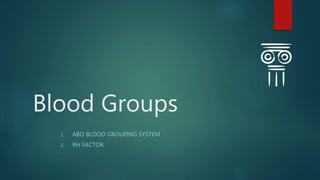
Blood groups
- 1. Blood Groups 1. ABO BLOOD GROUPING SYSTEM 2. RH FACTOR
- 2. How blood group is determined ! As per Mendel, every character is controlled by one pair of alleles. There are only two optional forms, one of which is Dominant and the other one is Recessive. Cases are observed where there are more than two optional forms of a gene for one character. Thus when three or more alleles are responsible for a single characteristic, they are known as multiple alleles. All these alleles occupy the same specific locus on the chromosomes. In a diploid cell, only two alleles can be present at a time on the homologous chromosomes. A well known example is the ABO blood type in humans. There are 4 main blood groups (types of blood) :– A, B, AB and O. Your blood group is determined by the genes you inherit from your parents. Each group can be either RhD positive or RhD negative, which means in total there are 8 blood groups. Rh was First discovered in Rhesus Monkey , That’s why called Rhesus Factor
- 3. Blood genotypes Here the inheritance is based on three alleles i.e. IA , IB , i . IA and IB are dominant and i is recessive. The gene for producing antigen I and it’s allele for non producing antigen is i . IA is responsible for producing Antigen-A. Gene 1B is responsible for producing Antigen-B. These two alleles are co-dominant which means that both can express themselves in presence of each other. Thus three alternatives are possible. Various persons in different blood groups can have following probable genotype.
- 4. To work out your blood group, your red cells are mixed with different antibody solutions. If, for example, the solution contains anti-B antibodies and you have B antigens on your cells (you're blood group B), it will clump together. If the blood does not react to any of the anti-A or anti-B antibodies, it's blood group O. A series of tests with different types of antibody can be used to identify your blood group. If you have a blood transfusion – where blood is taken from one person and given to another – your blood will be tested against a sample of donor cells that contain ABO and RhD antigens. If there's no reaction, donor blood with the same ABO and RhD type can be used. Blood group Serum test
- 5. In practice of blood transfusion. Karl Landsteiner discovered the ABO blood group in 1900 when he separated cellular and liquid components from both his and his colleagues’ blood mixed in combination. As indicated by the negative symbol (-) in the table , no agglutination of red blood cells was observed when both components from the same individuals were mixed. However, RBC agglutination was observed in some combinations, as indicated with the positive symbol (+). From the results gleaned from his studies, Landsteiner realized that people could be grouped depending on the agglutination pattern of their RBCs. For example, Dr. St. and Mr. Land. belong to one group. Similarly, Dr. Plee. and Mr. Zar. belong to a disparate second group, and Dr. Sturl. and Dr. Erdh belong to a third group. In the next year, a fourth group was discovered by Sturle and von Decastello, Landsteiner's colleagues, and these four groups became what is now known as the ABO group system (A, B, AB, and O groups). However, the most important finding obtained from these experiments is that only ABO-matched blood that does not cause RBC agglutination should be used for transfusion. Experiment
- 6. In order to explain the RBC agglutination phenomenon, Landsteiner postulated that 2 different antigens (A and B) are found on the surface of RBCs, and the "naturally occurring" antibodies against these antigens are found in the plasma of individuals who do not express them (The Landsteiner’s Law). For example, blood group A individuals express the A antigen on their RBCs and possess anti-B antibodies in their plasma. Similarly, blood group B individuals express the B antigen on their RBCs and possess anti-A antibodies in their plasma. Blood group AB individuals express both A and B antigens on their RBCs and possess neither anti-A nor anti-B antibodies, whereas blood group O individuals express neither A nor B antigens on their RBCs but possess both anti-A and anti-B antibodies. ABO blood groups are hereditary, and their mode of inheritance was explained by Bernstein’s one gene-three allelic model. In this model, Bernstein postulated that there are three alleles, A, B, and O, at a single ABO genetic locus, and that A and B alleles are co-dominant against the recessive O allele. This produces 6 genotypes (AA, AO, BB, BO, AB, and OO) resulting in 4 phenotypes. Landsteiner’s discovery
- 7. Pregnant women are always given a blood group test. This is because if the mother is RhD negative but the child has inherited RhD-positive blood from the father, it could cause complications if left untreated. RhD-negative women of child-bearing age should always only receive RhD- negative blood. Rhesus disease is uncommon these days because it can usually be prevented using injections of a medication called anti-D immunoglobulin. Pregnancy
- 8. Giving blood Most people are able to give blood, but only 1 in 25 people actually do. You can donate blood if you: are fit and healthy weigh at least 50kg (7st 12lb) are 17-66 years old (or 70 if you've given blood before) are over 70 and have given blood in the last 2 years